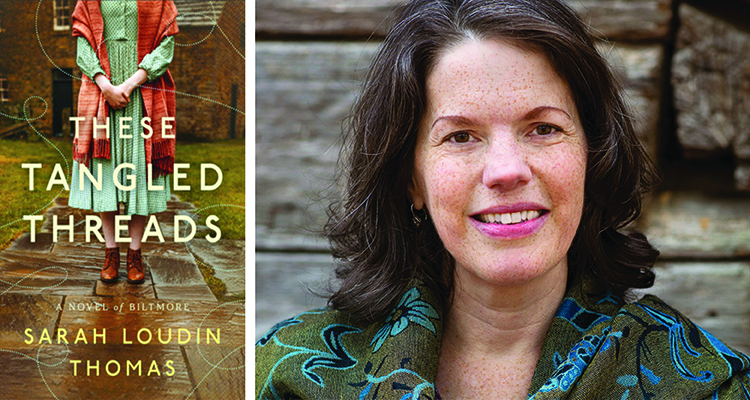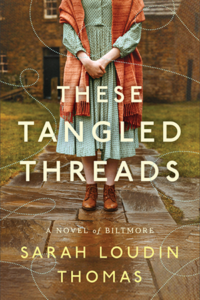Sarah Loudin Thomas is the author of numerous acclaimed novels, including The Finder of Forgotten Things, The Right Kind of Fool, winner of the 2021 Selah Book of the Year, and Miracle in a Dry Season, winner of the 2015 INSPY Award. Sarah worked in public relations for Biltmore Estate for six years and is currently the director of Jan Karon’s Mitford Museum. A native of West Virginia, she and her husband now live in western North Carolina.
In this interview, Sarah talks with us about her latest novel, These Tangled Threads.
FF: These Tangled Threads is set in the shadow of the famed Biltmore Estate. Can you tell us a little about this novel and why the title references weaving and textiles?
These Tangled Threads is about Lorna, a master weaver trained through Biltmore Estate Industries who has lost her creative spark. She’s experienced terrible loss and has become so focused on simply getting by that she has no room for passion and flair. When she’s commissioned to weave a unique pattern for Cornelia Vanderbilt’s 1924 wedding, she must revisit her past and the fact that many of the patterns she’s claimed as her own over the years were “borrowed” from someone else. In trying to protect herself, Lorna has made a tangled mess of her life and her closest relationships. Images of weaving, following threads, and untangling knots offer lots of great metaphors for the story!
FF: What makes you so uniquely qualified to write a story that features the history of Biltmore Industries?
In 2000, I started my then dream job in the public relations department at Biltmore Estate. I had so much fun learning the ins and outs of America’s largest privately owned home. Along the way I was fortunate enough to learn about some of the good work the Vanderbilts did in the community. That work included training young people in traditional crafts like weaving and woodworking. Having spent six years immersed in that history, it felt natural to incorporate it into my latest novel.
FF: How do you think your experience working in PR at the Biltmore enhances the novel?
In the beginning, I thought of Biltmore as a fairy-tale castle, but I came to learn that the Vanderbilts and the people they employed were so much more than figures in a history book. They were vibrant, exciting, real people with joys, sorrows, and stories to tell. In my time at Biltmore, I got to know some of the curatorial staff and the house hosts who are so incredibly knowledgeable about the history surrounding Biltmore. Being privy to behind-the-scenes insights made the story come alive for me and I hope for my readers.
FF: This book has it all—friendship, betrayal, romance, historical intrigue, all woven richly together. What are you most excited for readers to experience from your novel?
I’m always excited to share my love of Appalachia with readers. This is the first novel I’ve written that wasn’t set primarily in my home state of West Virginia. But it’s still very much in the Appalachian Mountains. I hope readers will feel like they’ve visited the beautiful green hills and might even plan to visit western North Carolina as a result. Come see Biltmore Estate, sure, but also take the time to drive out toward Weaverville or Black Mountain and experience the original beauty of this place that captivated the Vanderbilts.
FF: Who were the Vanderbilts, and what impact did they have on their community? Did that impact have a lasting permanence we can still see today?
George Vanderbilt was the grandson of “the Commodore” Cornelius Vanderbilt, one of the richest men of his time. While the rest of the Gilded Age wealthy were busy building houses in Newport, R.I., George discovered the mountains of western North Carolina and outdid them all in sheer size when he and Richard Morris Hunt dreamed up Biltmore House. While the obvious impact he left behind is on the tourism industry in WNC, I think the real value is in the way he preserved vast swaths of land that had been heavily farmed. Much of the original estate is now Pisgah National Forest—a treasure for the ages.
FF: One of the main drivers of the story is the wedding of Cornelia Vanderbilt. Why was this occasion so momentous in Southern history, and what significance does it have in the novel?
Cornelia Vanderbilt was beloved by estate workers and the locals. She played with the children of estate staff and was known as “Tarhell Nell” by locals. They saw her as one of their own. She even had a long-standing friendship with estate superintendent Chauncey Beadle. In the story, Arthur points out that Cornelia is wearing orange blossoms that Beadle sent her from retirement in Florida. That’s absolutely true. So her wedding was a momentous occasion for Asheville, especially as it was held in their mountain village rather than far away in New York City or Washington, D.C.
The fabric Lorna is commissioned to make for Cornelia’s wedding is fictional, but the Vanderbilt family certainly did lift up and celebrate traditional mountain crafts, and I think Cornelia would have treasured such a gift.
FF: This book centers around the lives of three former friends torn apart by their choices. Can you briefly introduce us to these characters? What should readers know about each of them?
Lorna Blankenship is a brown-eyed brunette who usually wears a serious expression. The loss of both parents has left her afraid to care or to feel too much. She’s dedicated herself to her work as a master weaver, but in tamping down her emotions she’s cut off any creativity she once had.
Gentry Cutshall is a young teen firecracker with light brown hair and green eyes. Her moods change like flipping a switch, and she has little control over her emotions. She pours her overabundance of energy into playing her dulcimer and is prone to disappearing into the fields and forests without telling anyone. She’s meant to become a weaver under Lorna’s tutelage, but her ability to focus on the work is limited. She is, however, wildly creative and artistic.
Arthur Wescott is the picture of solid dependability. Essentially fobbed off on the church as a child, he’s always made sure he’s indispensable so he’ll have a place in the world. He’s a big brother/father figure for Gentry and best pal for Lorna—although he wishes he were more to her. He’s the oil spread on troubled water wherever he goes. While he’s good-looking with wavy brown hair and hazel eyes, he has a clubfoot that affects his gait and, he believes, makes him less attractive.
FF: What lessons can we learn from the characters in These Tangled Threads and their struggles?
Each of the three main characters—Lorna, Gentry, and Arthur—experience childhood trauma in the form of loss or abandonment, and each are impacted by and deal with that trauma differently. Everyone experiences trauma at some point in their life. I hope readers can find echoes of their own sorrows in this story and hopefully ideas about how healing and recovery are possible.
FF: What aspect of this story did you enjoy writing the most?
I really enjoyed writing from the point of view of estate workers. When people think of Biltmore, they often focus on the Vanderbilts, the vast wealth, or the treasures on display. Writing about the Christmas party enjoyed by estate staff or the work that went into Cornelia’s birthday surprise—that was fun for me! And estate workers did get Cornelia a game bag for her birthday, for she loved the outdoors.
FF: What are you working on next?
My next story will once again be set in western North Carolina. This time I’m heading farther north and east to Hot Springs and Black Mountain. During WWI a mountain resort was transformed into a camp for German enemy aliens. These were men and women who happened to be on ships in America when war was declared in 1917. At that point, the United States extended them a long-term welcome. Sailors, travelers, and even a full orchestra were housed at the resort. Jump ahead to 1932 and a woman in Germany whose fiancé was on one of those ships. She doesn’t know what happened to him until she sees a photo in a newspaper of the German ambassador to the U.S. placing a wreath on a memorial to Germans who died in the camp. Among the names is that of her fiancé. She’ll travel to America to try to learn what happened even as the election of Hitler as German Chancellor throws her own country into turmoil.
These Tangled Threads
A Novel of Biltmore Estate
Sarah Loudin Thomas
Bethany House
Genres: Southern Fiction, Historical
Release Date: April 2, 2024
ISBN-10: 0764242016
ISBN-13: 978-0764242014
Book Summary:
Set in the shadow of Biltmore Estate, a poignant tale of friendship, restoration, and second chances.
Seven years ago, a hidden betrayal scattered three young friends living in the shadow of the great Vanderbilt mansion. Now, when Biltmore Industries master weaver Lorna Blankenship is commissioned to create an original design for Cornelia Vanderbilt’s 1924 wedding, she panics knowing she doesn’t have the creativity needed. But there’s an elusive artisan in the Blue Ridge Mountains who could save her—if only she knew where to begin.
To track down the mysterious weaver, Lorna sees no other way than to seek out the relationships she abandoned in shame. As she pulls at each tangled thread from her past, Lorna is forced to confront the wounds and regrets of life long ago. She’ll have to risk the job that shapes her identity, as well as the hope of friendship—and love—restored.
Buy These Tangled Threads from the from the FF Store HERE!
Buy These Tangled Threads from Through the FamilyFiction Amazon Affiliate HERE!



